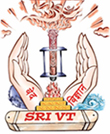 info.srivt@gmail.com
info.srivt@gmail.com 08632950470 / 08634010911 / 9493936388
08632950470 / 08634010911 / 9493936388
Ancient Metallurgy
Vedas are apaurusheya, which means they are not compilations of human knowledge. Vedic knowledge comes from the spiritual world,… Vedic injunctions are known as shruti. From the original Veda Samhitas up to the Upanishads are classified as shruti. The additional supplementary presentations of these principles as given by the great sages are known as smriti. They are considered as evidence for Vedic principles. Understanding the ultimate goal of life is ascertained in the Vedanta-sutras by legitimate logic and argument concerning cause and effect.
As per ‘Sayanacharya’ every Veda- sabda is interpretative of six meanings e.g., Vachyardha, Sutrardha, Lakshnardha, Yajnardha, Bhavardha/Viseshika ardha and Oshadhi ardha. The Bhashya of Veda will be well-defined basing on conditions of society i.e. time tested. Yajnardha (spiritual or sacrificial meaning) as an apt meaning for this Yuga, what ‘Sayanacharya’ felt justify. So, Sayanacharya has taken ‘yagnardha’ for his work of Veda Bhashya.
The six meaning of ‘Oshadhi Ardha’ indicates the material knowledge of universe. Our ancestors, as well as the scientific world are consolidating the universe into two, i.e. Matter (padardha, visible) and Energy (Sakthi, invisible). These two are inter-dependable. ‘’Sabdam vina naiva kadapi tejah’ tejo vina naiva kadapi sabdah’. Without energy, matter will not be useful, likewise without matter, energy won’t exposed.
Now, energy will be in two forms, those are Sabda Brahma (Sound waves) and Jyothirbrahma (Light waves). Vedic wisdom will come under Sabda Brahma and celestial bodies (Stars, Planets etc.) come under Jyothirbrahma. Chanting Mantras while performing Homa or yajna is a dual application of both energies.
Basically, Sabda brahma generated the Matter. From Sabda-Brahma (Pranava Nadam- Omkaram) only the evolution this universe began. Then the Mahath (DNA of Pancha Bhutas) next Ahamkara (existence) to Akasa to Vayu to Agni to Apah to Prithvi to Oshadhi to Anna to Retha to Purusha, like this evolution theory was described in Vedas. ‘Pancha Bhuthaathmikam Jagat, Pancha bhouthikam deham’, this principal indicating us, the construction of Physical body to universe is five elemental structures.
Metallurgy is the process of working metal into artifacts (tools and toys).Although small amounts of metals are found in relatively pure form, most must be extracted from more complex ores by removing the “impurities” (non-metal or other metal) from the combination ore.
For Example:
मयूरा ीवासंकासामि सथेघो ीरसि भम
अपसूच वथेि मइतंमयुरतु कम्
Text source: Ananda Kanda;
Chapter: Sodhana Prakaranam
Translation: Powdered mayura Tuttam is kept in the water, it dissolves in it very quickly and easily. Here mayuratuttam cannot influence the iron speedily, all other metals are consumed by it. So we have taken iron vessel to dissolve the CuSO4. So, in iron vessel (pan), we kept the mayuratuttam with water for a night. We found a copper thin sheet attached to iron pan. FORMATION OF PURE ULTRA FINE COPPER.
Ancient Chemistry
Ancient India, as in other fields made great contributions in the field of Chemistry too. An important role in the development of Chemistry was made by Ayurveda which used a variety of minerals. Chemistry in Ancient India was called Rasayan Shastra, Rasatantra, Rasa Kriya or Rasa Vidya roughly translating to ‘Science of Liquids’.
Ancient Aeronautics
The Vaimānika Śāstrareveals the topic of ‘science of aeronautics’. A significant part of aeronautical science is a branch of dynamics called aerodynamics, which deals with the motion of air and the way that it interacts with objects in motion, such as an aircraft. The Yujurveda quite clearly tells of a flying machine, which was used by the Asvins (two heavenly twins). The Vimana is simply a synonym for flying machine. It occurs in the Yajurveda, the Ramayana, the Mahabharata, the Bhagavata Purana, as well as in classical Indian literature. At least 20 passages in the Rig Veda (1028 hymns to the gods) refer exclusively to the flying vehicle of the Asvins. This flying machine is represented as three-storeyed, triangular and three –wheeled. It could carry at least three passengers. According to tradition the machine was made of gold, silver and iron, and had two wings. With this flying machine the Asvins saved King Bhujyu who was in distress at sea.
Vedic Meteorology
The present work deals with the Vedic Science of Weather Modification. It lays down the theory and principles of Vedic operation for inducing rain and anti-rain. It also briefs up the readers with methods of rainmaking attempted in India from time to time right from the Vedic period down to the present day. It also highlights the methods of weather forecast (from short range to long range) applied by the ancient Indians. This is the second revised, updated and enlarged edition. It features new chapters on Somayaga (Vedic Science of Rain-formation) and AgnisomÏya Pashuyaga (The Process of Rain-formation as defined in the Vedas).
Vedic Technology
The Vedic civilization, according to the ancient scriptures, was at a much higher level of development than our modern society. In Sanskrit “veda” means knowledge.
It was a scientific “explosion” in physicist circles when the scientists have discovered the vivid description of subatomic level in the Vedas written some five thousand years ago.
For example, it is stated in the Bhagavata Purana:
“The material manifestation’s ultimate particle, which is indivisible and not formed into a body, is called the atom – Param anuh. It exists always as an invisible identity, even after the dissolution of all forms. The material body is but a combination of such atoms, but it is misunderstood by the common man.” In the same Bhagavata Purana the different time scales are explained, starting with the atomic. The theory of relativity and quantum physics can be substantially supplemented by information from the Sanskrit texts.
Join us as member to make again our Bharat as "Viswa Guru"
Srimaharshi Aarshavijnanadi Gurukula Mahavidyalaya (Virtual University)


